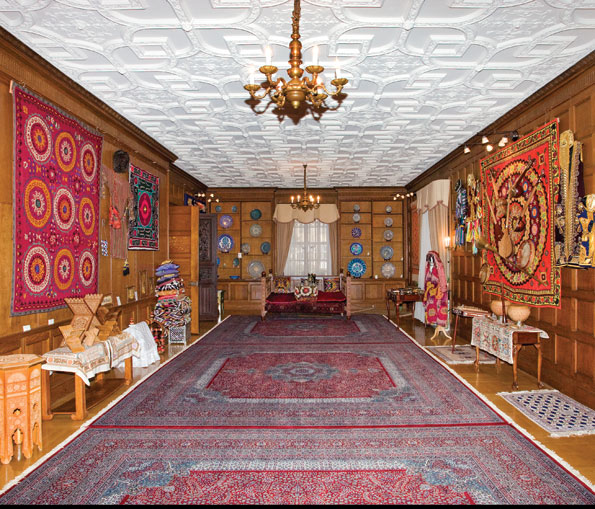
The former library, now the Gallery of Ethnographic Art, showcases objects from the rich cultural heritage of the Republic of Uzbekistan. The collection is constantly expanding due to gifts from visiting delegations, prominent artists, individual donors, and embassy personnel.
While many grand Washington residences met their end during the Great Depression, the Moore Mansion survived largely untouched as a residence for Canadian diplomats. It was later reserved for official functions until 1988, when the Canadian Embassy moved its offices to Pennsylvania Avenue NW.
Boasting a prime location on Embassy Row, it was no surprise when the Republic of Uzbekistan purchased the building in 1996 to use as its Washington embassy. In Canadian tradition, all of the architectural details inspired by 16th-, 17th-, and 18th-century French, English, and Italian artisans were preserved.
Coming from a land known for woodcarving, stained glass, decorative painting, and other rich artistic traditions, it was imperative that the Uzbekis also weave the fabric of their heritage into the bones of the building. The entry hall of the classical structure shows little Uzbek influence other than the nation’s flag, proudly displayed at the far end of the main hall. As soon as you turn the corner into the Gallery of Ethnographic Art, however, the aesthetics change. Hung on neo-Tudor cherry panels are many vibrant and patterned textiles, ceramics, clothing, and furniture – all displayed in an artistic outpouring of Uzbeki culture and the traditions of the Silk Road.
The main rooms are located on the second floor, the piano nobile of traditional western architecture. In the grand staircase that rises above the entrance hall, the original windows were replaced with stained glass panels in traditional folkloric designs. Here, geometric patterns characteristic of Uzbek art are contrasted by intricate neo-classical ornamentation.
This elegant pairing of East and West is a recurring theme throughout the embassy, where subtle changes and an infusion of culture give new life to the storied building.
See more photos on the following pages….
